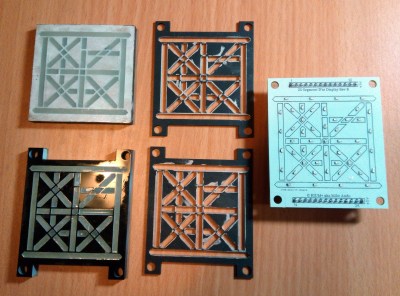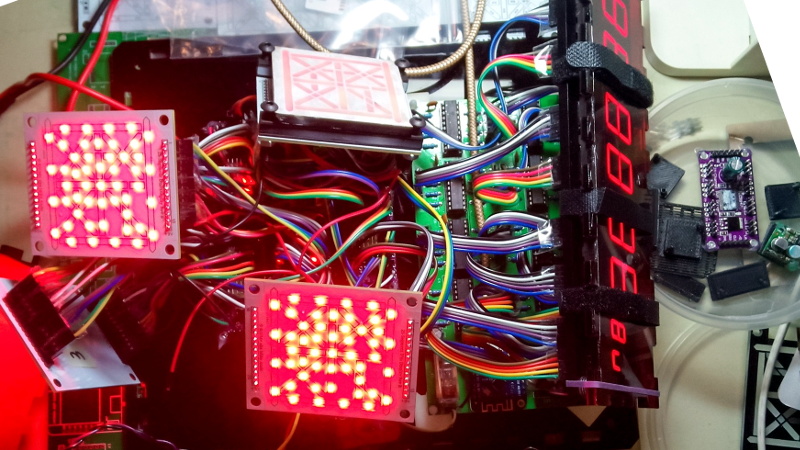The Myst fans in the audience will love this project because it displays the 25-hour timekeeping system of the D’ni. The hardware hackers will lean a little closer to their screen because it does so with custom made 25-segment LEDs, and the precision obsessed will start breathing heavily when they hear it maintains an accuracy of 0.001 seconds. As for which of those camps creator [Mike Ando] most identifies with, we can’t say. But we definitely respect his style.
We’ll spare you the in-depth description of the base-25 number system apparently used in the Myst franchise. If you’re interested enough you can click on through to the project’s Hackaday.io page and learn how to actually read the clock. Presumably you’ll then come back here and leave your comment in Klingon.
 Let’s instead jump right to the part that really gets us excited, those custom displays. To create them, [Mike] cut the face out of black acrylic with a laser, and filled each void with a mixture of clear resin and very fine gypsum plaster. Getting the mix right can be a little finicky as the plaster can clump up, but the end result diffuses the light nicely. The acrylic front panel and a couple of cardboard “gaskets” to keep the light from leaking onto adjacent segments is then stacked on top of a PCB with corresponding 0603 SMD LEDs.
Let’s instead jump right to the part that really gets us excited, those custom displays. To create them, [Mike] cut the face out of black acrylic with a laser, and filled each void with a mixture of clear resin and very fine gypsum plaster. Getting the mix right can be a little finicky as the plaster can clump up, but the end result diffuses the light nicely. The acrylic front panel and a couple of cardboard “gaskets” to keep the light from leaking onto adjacent segments is then stacked on top of a PCB with corresponding 0603 SMD LEDs.
Beyond the soul-crushing number of wires required to hook everything up internally, the rest of the project is relatively straightforward. It uses a WeMos D1 Mini to connect to the WiFi network and pull the current time down from the geographically closest NTP server every couple of hours. Rather than putting a temperature controlled oscillator on the board, [Mike] has decided to pin his accuracy on a constantly on Internet connection and aggressive synchronizations.
From impressive curved bar graph modules to displays segmented with household items, we’ve seen our fair share of custom indicators. But we have to admit that building 25-segment LED displays for the alphabet of a fictional interstellar species sets the bar pretty high.















Bragging about 1ms precision is like bragging about how you can accurately measure position accurate to the nearest mile.
A dollar store watch can keep time accurate to a millisecond, a low grade scientific quartz crystal can do better than a nanosecond, and a bottom of the line atomic clock (costs about $100) can do better than a picosecond. Unless considering mechanical clocks (as in, powered by a spring…) one would have to work fairly hard to add timing error to get worse than a millisecond of accuracy…
Cool displays tho
I get your point, accuracy is cheap these days.
But 1ms per what? 1ms per day, per month, per year?
For a clock (unless it is set every millisecond) 1ms on it’s own means nothing.
But regarding accuracy and commonly available clocks, when you make one your own, there are still a lot of things there can go wrong. If you have your own oscillator, it still needs to be trimmed, but how accurate is your measurement, doesn’t your tool influence it? Is your tool properly callibrated or even up to the task?. Is your oscillating circuit properly shielded against electromagnetical fields, or perhaps your clock is standing on something that resonates and experiences interfering mechanical stresses. How about thermal drift, thermal stress or voltage dependencies… lot’s of things can go wrong.
Even if you use network time (although I consider that “cheating”) you can still can go wrong there (offset due to processing delays) or simply by not updating enough and allowing the cheap internal clock (that is set by the “precise” network time) to drift.
But this project is more about the display then the clock. And I must say that display is very nice (and interesting to watch), I must keep this construction method in mind, so thanks for posting.
1 ms for a budget quartz watch? You got extremely lucky.
A time-lord from the NIST ran a study on four commodity/dress watches: https://tf.nist.gov/general/pdf/2276.pdf
The result is drift of between 70 and 500 ms per day, with only one watch under 100 ms. Per day. So let’s say two orders of magnitude.
This Myst clock will be within 1 ms over long term. Whether connecting to an NTP server is cheating or not is up to debate. But that this clock is better than anything else I have running in the house, except maybe my cell phone and/or a GPS, which cheat in similar ways, this is pretty cool.
It is a cheat because it essentially runs a closed loop for frequency as well as time syncing.
Try it without internet connection.
I have several DCF77 synchronized clocks in my home, even my watch uses this time signal.
I think you are confusing precision (or resolution) for accuracy. Dimestore watches with a 32768 hz Crystal have a 1/32768 s resolution. Drift is ~15s per month or so. Accuracy, or closeness to actual time, is another thing altogether– it can be spot on (within 1/32768 s of actual) or off by minutes or hours.
The atomic clocks you mention have a much shorter resolution (1/6834682610.904 Hz for rubidium) and much lower drift. If you make a clock with such a device, it will have better resolution and drift but accuracy is another thing altogether, i.e. can be set to the wrong time.
In the article, they explain they used frequent queries to a geographically nearby NTP server instead of an accurate timebase (temperature controlled oscillator). In other words, they strove for accuracy instead of stability.
Ah, but to truly appreciate Myst, you have to play it, in it’s original Klingon.
Ignore all punctuation between first comma and full stop.
I don’t play Myst, so I don’t know. It sort of looks like the countdown timer in Predator. Speaking of which, does anybody have an implementation of that?
Dun batlh ghaj bey’!
Only need to slow earths rotation no and move it out some.
Looks like something that a Predator would use
https://youtu.be/xEvb7B4O698?t=67
Did the game Pyst use the same clock?
B^)
https://arstechnica.com/gaming/2020/01/video-how-mysts-designers-stuffed-an-entire-universe-onto-a-single-cd-rom/ On queue, Ars has an interview with Rand, co-creator of Myst.
Original creator here; think of this as similar to the old master/slave clocks that you used to see (and sometimes still do see) at schools/universities/train stations etc. It has its own onboard crystal to get it by (which is constantly monitored with feedback to give a far better result than a dumb slave clock normally has), and it regularly synchronises itself with a far more accurate clock. Given this, it should highly likely never drift outside 3ms of the actual time, and should usually be <1ms. If the internet drops out, it lights up the dots in the 7-seg displays in binary to estimate milliseconds of imprecision (but once it's been on for a few hours and reached a thermal steady state, that's only a little over 1ms per day, and if I've got no internet for days I've got bigger problems than my wall clock being off by a few milliseconds).
Also, this is Hackaday… There are no cheats. If something works through unconventional means, that's called a hack ;)
How many standard clocks are there, anyway? Aren’t they all eventually synced to one source?
Given that, it’s just a matter of the update frequency. :)
Anyway, the plaster as diffuser in the resin is gold!
I also have “custom” clock -> https://www.youtube.com/watch?v=PwaL0ruSkfg